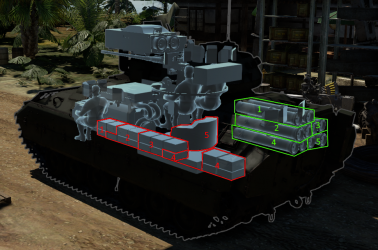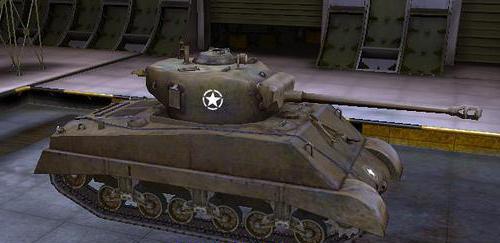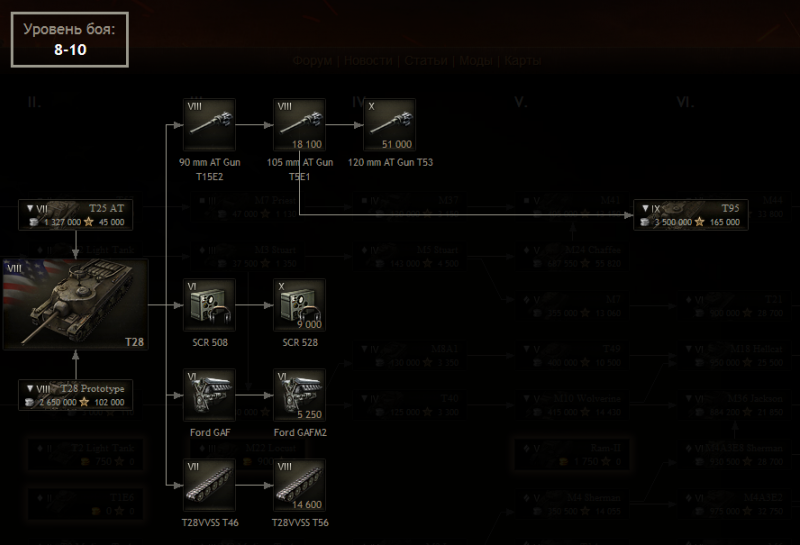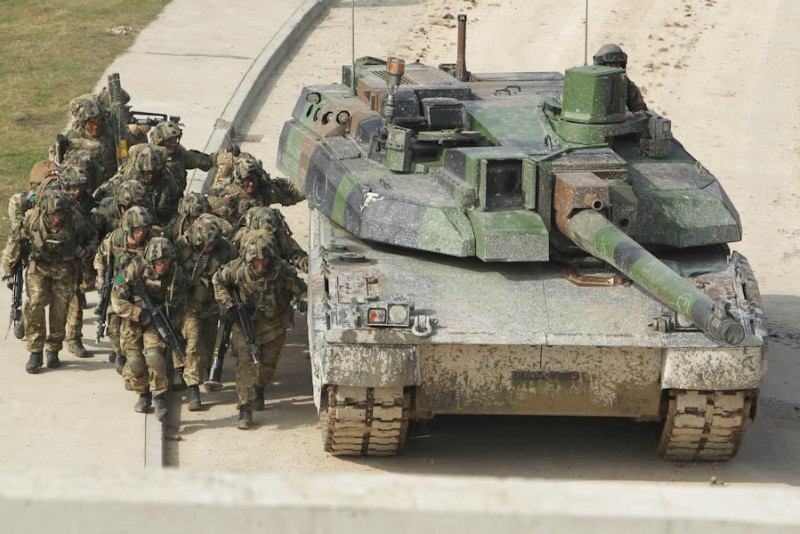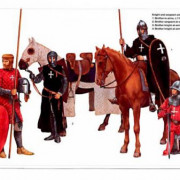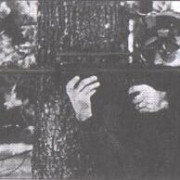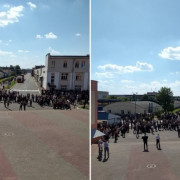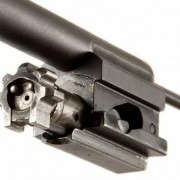Мардер (бмп)
Содержание:
Description

The Marder III is a rank II German tank destroyer
with a battle rating of 2.7 (AB/RB/SB). It was introduced in Update 1.43.
The armour of the Marder is its biggest fault. Because it is open-topped, strafing runs from fighter planes can disable the crew very easily, even leading to ammo detonation! Enemy tanks only have this privilege because of poor positioning of the Marder, or because of a highly exploited breakthrough of allied defences. The front turret armour is also very thin and is vulnerable to basically any weapon save most 7.62 mm MGs. The hull armour at the front is rather thick at 50mm and is decently sloped for a tank destroyer. It still should not be relied on heavily, but if angled correctly it can be used to deflect British 2 pdr. guns, German, US and Russian 37 mm and sometimes 50 mm guns, as well as most ammunition used by the KV-1 series of tanks.
The Marder also has surprisingly poor manoeuvrability for a small tank destroyer. Being based on the Pz.38(t) chassis, forward turning abilities slow the tank down significantly and neutral turning leaves a lot to be desired. The fact that the Marder has a forward facing gun with no turret means that it is required for the whole vehicle to turn to align the gun onto target if out of its arc of fire. Therefore, it is highly recommended to play with a squadmate or more mobile player, as the mobility of the Marder can significantly hamper urban combat abilities. Use the high speed of the Marder to reach a comfortable shooting position and stay there- the poor traverse and turning speed is fatal against nearly all turreted vehicles, along with the very poor armour.
However, the Marder makes up for most of these drawbacks with its high velocity, high damage 76 mm cannon. It can OHK every single tank within the 1.7-3.7 BR range. Whether it be a Sherman, T-34, or Churchill, no UFP (upper front plate) is safe. Ballistics are very similar to all other 75mm long guns in the German line (IV F2, Marder III H, etc.), and thus experienced German tankers should not have issues assimilating to the Marder’s cannon.
Murder and religion
The unlawful killing of another human is seen as evil and a sin in all of the world’s major religions.
Religions such as Hinduism and Buddhism espouse beliefs of absolute non-violence. The Hindu Laws of Manu state:
He who commits murder must be considered as the worst offender, more wicked than a defamer, than a thief, and than he who injures with a staff» (Laws of Manu 8.345).
The Buddhist Dhammapada says:
The Islamic Qur’an bars unjust killing: «And slay not the soul which God has forbidden except for the just cause…» (17:33) and «…If anyone killed a person not in retaliation for murder or to spread mischief in the land, it would be as if he killed the whole of mankind. And if anyone saved a life, it would be as if he saved the whole of mankind» (Surah Al-Maaida 5:32).
In Judaism and Christianity, murder is banned in the Ten Commandments. Supporting this view is the passage in the Gospel of Matthew 26.51-52:
In the Jewish Talmud is recorded:
Sun Myung Moon, founder of the Unification Church, has echoed this sentiment,
БМП «Мардер-2»
В 1985-ом году германским министерством обороны было объявлено среди программ имеющих приоритетные направления о разработке боевой машины пехоты нового образца — «Mардер-2». Необходимость в боевых машинах оценили тогда в 2,5 тысяч единиц. В 1988-ом году компанией Krauss-Maffei был получен заказ, подтвержденный контрактом по разработке нового образца. В начале осени, в 1991-ом году прошла демонстрация первых прототипов БМП с наименованием «Mардер-2».
Машину многое отличало от предыдущего варианта. Механик-водитель располагался теперь справа в передней части, а командир БМП с наводчиком-оператором расположились в сравнительно вместительной башне с той же конструкцией, первый с правой стороны от орудия, а второй — с левой. Десантный отсек вместил в себя семь военнослужащих с полным боевым снаряжением.
Масса машины достигает 42 тонн, а это уже соответствие массе многих основных танков. «Мардер-2» оснастили дизелем компании MTU с мощностью почти 1000 л.с. Двигатель с гидромеханической трансмиссией, располагает гидрокинетическими передачами, коробкой передач планетарного типа, сумматорами и механизмом поворотов. Все это является единым блоком, постоянно контролируемым и регулируемым компьютерной системой.
https://youtube.com/watch?v=wK5ZYVotL2M
В ходовой части БПМ имеется шесть пар колес с двойными обрезиненными опорными катками, и поддерживающими роликами, и ведущие колеса, расположенные впереди, а также направляюще колеса, расположенные сзади и резинометаллические гусеницы. Подвеска оборудована торсионными валами.
На «Мардерах-2» установлены автоматические пушки Rh503 Mk35/50. Орудие укомплектовано стволами в количестве двух единиц, калибров 35 и 50 мм, быстро заменяемыми при особой надобности. В сравнении с «Мардером-1» на втором была значительно усилена огневая мощь. Вся механика, связанная с автоматикой орудия, оснащена электрическими приводами. Энергия пороховых газов применяется только для стрельбы снарядами.
Огонь пушкой мог вестись как в одиночном режиме, так и очередью. Боевая скорострельность регулировалась в пределах от 150 до 400 выстрелов в минуту. Заряжалась пушка с обеих сторон. Стрельбы велись с помощью специально разработанных унитарных боеприпасов. Это стабилизирующиеся в полете подкалиберные трассирующие и осколочно-фугасные снаряды.
Дополнительным вооружением в боевой машине пехоты «Мардер-2» является:
- Пусковая установка ПТУР противотанковых управляемых ракет (ПТУР «Милан»);
- Пулемет с калибром 7.62 мм;
- Дымовые гранатометы численностью десять единиц.

Чтобы успешно противостоять противнику с сильно бронированной боевой техникой, на «Мардерах-2» специально был установлен ПТРК третьего поколения PARS-3MR. Противотанковые ракеты указанного комплекса обладают лазерной системой наведения с тандемной кумулятивной боевой частью.

Автор статьи:
Богуславский Сергей
Я бывший военнослужащий, офицер, и военная тематика мне близка, я в ней легко ориентируюсь.
General info
Survivability and armour
Armour type:
Rolled homogeneous armour
| Armour | Front (Slope angle) | Sides (Slope angle) | Rear | Roof |
|---|---|---|---|---|
| Hull | 50 mm (19°) Front plate 12 mm (74°) Front glacis 50 mm (13°) Lower glacis | 16 mm Upper 15 mm Lower | 15 mm | 12 mm |
| Turret | 11 + 8 mm (31°) | 11 mm (8-9°) | N/A | N/A |
Gun and MG horizontal displacement of the Marder III
Notes:
- Belly armour (under the tank) is 15 mm thick.
- Suspension wheels and tracks are 15 mm thick.
- Aside from the front gun shield, there is no armoured encasement for the gunner and loader crew members.
- The vehicle is so lightly armoured that it is extremely vulnerable to artillery strikes, plane strafings, ramming attacks and light machine gun fire.
Mobility
| Game Mode | Max Speed (km/h) | Weight (tons) | Engine power (horsepower) | Power-to-weight ratio (hp/ton) | |||
|---|---|---|---|---|---|---|---|
| Forward | Reverse | Stock | Upgraded | Stock | Upgraded | ||
| Arcade | 46 | 6 | 11.3 | 227 | 305 | 20.09 | 26.99 |
| Realistic | 42 | 6 | 142 | 160 | 12.57 | 14.16 |
Development
Marder I of the 21st Panzer in Normandy, converted from Hotchkiss, 1944.
The Marder I was developed in May 1942 by Major Alfred Becker. It carried the 75 mm PaK 40 anti-tank gun on a Lorraine chassis. As the gun was relatively large, the original crew compartment superstructure was removed to create the space needed to work the gun. This was done at . The gun was then mounted atop the chassis. Alkett, working in conjunction with Becker, produced the angled armour shielding for the crew compartment. The shielding was relatively light, and was open from above. The shielding provided the crew with protection from blast and small arms fire, but was not intended to stop armour piercing rounds. The vehicle’s primary function was to provide mobility to the anti-tank gun. It was not intended as a replacement for a tank.
Between July and August 1942, 170 Marder I’s were built on the Lorraine chassis. Later, several other French and Polish tanks were used as the conversion base for the Marder I, including the Hotchkiss H39 and FCM 36. These conversions were also completed at Baustokommando Becker, though fewer of these were built. The Marder Is initially served in infantry divisions on the Eastern Front and met with good success. They later made up a significant component of the armoured fighting vehicles of the reformed 21st Panzer Division in Normandy.
Модификации
- SPz NEU — десять предсерийных образцов, выпущенных в период с октября 1968 по март 1969 года. Оснащены шестицилиндровым многотопливным двигателем «Даймлер-Бенц» MB833Ea (600 л.с.).
- «Marder» (после 1985 года название изменено на «Marder-1») — первая серийная модель, производилась с 1970 по 1975 год (всего выпущено 2136 машин). Боекомплект изначально составлял 1250 20-мм патронов и 2500 патронов к пулемётам.
- «Marder» с установленной на башне пусковой установкой ПТУР «Милан». Модификация разработана в 1975 году, в период с 1977 по 1979 годы ПТУР были установлены на все 2136 машин. В боекомплект включены шесть ПТУР «Милан».
- Marder 1 A1 — модернизированный вариант, разработанный в 1979—1980 годы и поставленный в производство в 1981—1982 годы. Электромеханический механизм поворота башни был заменен на более мощный. 20-мм пушка была снабжена механизмом селективного питания, позволяющим переходить от ведения огня осколочно-фугасными снарядами к стрельбе бронебойными снарядами. В боекомплект к пушке был введен выстрел с бронебойным подкалиберным снарядом DM63, кроме того, боекомплект был увеличен до 1284 выстрелов (из них 317 бронебойных). Около 1000 машин планировалось оснастить пассивным инфракрасным прицелом с тепловизионным индикатором, однако фактически он был установлен на 674 машины.
- Marder 1 A1A3 — Marder 1 A1 с новой радиостанцией SEM 80/90.
- Marder 1 A2 — вариант модернизации, проведенной в 1984—1991 годы.
- Marder 1 A2A1 — Marder 1 A2 с новой радиостанцией SEM 80/90.
- Marder 1 A3 — модификация 1989 года. Масса бронирования увеличена на 1600 кг с целью:
- — непоражаемости машины в переднем секторе обстрела БПС снарядами 30-мм пушки БМП-2;
- — для усиления защита горизонтальных поверхностей (крыши корпуса и башни) от поражения кумулятивными боевыми элементами кассетных боеприпасов за счёт использования разнесенной брони.
- Marder 1 A4 — вариант Marder 1 A3 с новой криптографической радиостанцией SEM 93.
- Marder 1 A5 — модернизированный вариант Marder 1 A3, разработанный в 2003–2004 гг. Установлена дополнительная противоминная защита, полностью изменён интерьер с целью уменьшения повреждений экипажа и десанта в случае подрыва на мине. В ходе модернизации было обновлено 74 машины Marder 1 A3.
- Marder 1 A5А1 — модернизированный вариант Marder 1 A5, разработанный в 2010–2011 гг. Установлена система кондиционирования воздуха, мультиспектральное камуфлирование корпуса и системы РЭБ. Модернизации подверглось около 35 едииниц.
Также, на базе «Marder» были созданы и приняты на вооружение бундесвера:
- самоходный ЗРК Roland с двумя ракетами в положении готовности и восемью в резерве
- машина наблюдения с радаром на гидравлически управляемом основании.
Источники
- Н. Мишин. Модернизация БМП «Мардер» // «Зарубежное военное обозрение», № 2, 1981, стр.88
- International Institute for Strategic Studies. The Military Balance 2016 / James Hackett. — London: Taylor&Francis, 2016. — С. 101. — ISBN 9781857438352.
- International Institute for Strategic Studies. The Military Balance 2016 / James Hackett. — London: Taylor&Francis, 2016. — С. 257. — ISBN 9781857438352.
- International Institute for Strategic Studies. The Military Balance 2016 / James Hackett. — London: Taylor&Francis, 2016. — С. 386. — ISBN 9781857438352.
Главный редактор — Крис Бишоп. «Современная боевая техника». стр 46
Special Abilities[edit | edit source]
| Name | Activation Time | Duration | Reload Time | Ability | Changes |
|---|---|---|---|---|---|
| Designate Target | 2 s | 20 s | 50 s | The designated target remains visible and receives full damage. |
Component saving -10%Crew saves -10%Camouflage factor -100% |
| Deploy AT Squad | 1 s | N/A s | N/A s | Anti-Tank troops set ambushes that are highly effective against lightly armored vehicles. |
Deploy 4 Anti-tank troops |
| Sniper drop | 1 s | N/A s | N/A s | The sharpshooter is also a great scout, very effective against enemy infantry and capable of destroying vehicle optics. |
Deploy 1 Sniper |
| Mortar squad drop | 1 s | N/A s | N/A s | Mortar squad delivers stand-off indirect plunging fire. | Deploy 1 Mortar squad |
HistoryEdit
Development of the Marder ran from January 1960, when the first development contracts were issued, to 7 May 1971, when the first production vehicles were given to the German army.
In 1967, after military requirements were finalized, a third and final set of ten prototypes were built. Final development work was completed by the Rheinstahl group, and 10 pre-production vehicles were built and completed troop trials with the German army between October 1968 and March 1969. In May 1969, the vehicle was officially named the «Marder» and in October Rheinstahl was chosen as the prime contractor.
The first production Marder 1 was handed to the German army on 7 May 1971. Production of the vehicle continued until 1975, with 2,136 vehicles being completed. In 1975 the Milan missile was first adapted to be fired by commander from his open hatch, and between 1977 and 1979 Milan missiles were fitted to army vehicles. A number of upgrade programs were carried out, that included fitting night vision equipment and a thermal imager, as well as an upgraded ammunition feed to the 20 mm cannon.
Around 1985 the designation was changed to Marder-1 (until then it was simply Marder) since a follow-up IFV was under construction. Since the new vehicle should be the partner of the Leopard-II just like Marder was the companion to the Standardpanzer/Leopard I, it was named Marder-2 and the older vehicles re-designated.Prior to the developement of the Bradley fighting vehicle the U.S. Army considered aquiring the Marder.
Credits
New World Encyclopedia writers and editors rewrote and completed the Wikipedia article
in accordance with New World Encyclopedia standards. This article abides by terms of the Creative Commons CC-by-sa 3.0 License (CC-by-sa), which may be used and disseminated with proper attribution. Credit is due under the terms of this license that can reference both the New World Encyclopedia contributors and the selfless volunteer contributors of the Wikimedia Foundation. To cite this article click here for a list of acceptable citing formats.The history of earlier contributions by wikipedians is accessible to researchers here:
- Murder history
- Felony_murder history
The history of this article since it was imported to New World Encyclopedia:
History of «Murder»
Note: Some restrictions may apply to use of individual images which are separately licensed.
Combat history
The first Lorraine-based Marder I vehicles were sent to the Eastern Front in 1942 to serve in the Panzerjäger (tank destroyer) units of infantry divisions.
This is a list of Infantry Divisions operating on the Eastern Front known to have used Marder I’s and the estimated time frame they were used
| Division | Battalion | Time Frame |
|---|---|---|
| 31.Inf. Div | Pz. Jg.Abt.31 | Aug 42 — Dec 43 |
| 35.Inf. Div | 2.Kp./Pz. Jg.Abt.35 | Sep 42 — Dec 43 |
| 36.Inf. Div (mot) | 4.Kp./Pz. Jg.Abt.38 | Oct 42 — Jun 43 |
| 72.Inf. Div | 3.Kp./Pz. Jg.Abt.72 | Sep 42 — Dec 43 |
| 206th Inf. Div. | 1./Pz. Jg.Schn. Abt.206 | Jan 43 — Dec 43 |
| 256.Inf. Div | 5./Pz. Schnelle-Abt.256 | Nov 42 — Apr 44 |
| 227. Inf. Div | ~2. &/or 3.Kp. Pz. Jg.-Abt.227 |
Per various Panzer Tracts, 7-2 notes: «On 14 August 1942, … Gen.Qu. was requested to include 72 — 7.5cm Pak40 (Marder I) Lorraine on Blitztransport trains.» (6 initially noted divisions issued 9 and then 10 Marder I «in accordance with K.St.N.1148a dated 15Feb42 for a Panzerjaeger-Kompanie (9 Sfl.)» then «10 7.5cm Pak40/1 auf Sfl. Lorraine-Schlepper and organized in accordance with K.St.N.1148a dated 1Dec42.» Thus utilizing 54 (6 x 9) to 60 (6 x 10) of 72 Marder I shipped. Thus 12 Marder I available for 227th Infantry Division.
Alfred Becker notes: «By Christmas 1942 almost all of Becker’s men had reached Paris. In exchange for the men Becker provided the commander of the 227th Infantry Division with 20 of his armoured vehicles.». This follows on from the ground breaking pre-Pz. div. developmental use of the Becker’s first conversion vehicles: 12x 10.5cm leFH 16 Geschutzwagen auf Fahrgestell Mk VI 736(e) & six of the larger 15 cm sFH13 guns on Mk VI 736(e) by the 227th Inf. Div.
Pz Tr No. 10 notes: «Two additional leFH18/4 (Sf.) mounted on Lorraine Schlepper chassis were completed with a modified superstructure (similar in design and purpose to the 38t Grille sIG 33, with an additional 12 built for and used by the 2 PzGren Regts of 21 Pz. div.) and delivered in early December 1942 as a new Sturmgeschuetz-Zug for the 15.Batterie/Artillerie-Regiment 227.» (Of 227th Inf.Div.). So far, we get 20 — 12 — 2 = 6 FR Sfl outstanding from Baukommando Becker.
Pz Tr No.10 also notes: «An additional 64 sFH13 (after the first 30 built in June 42 and shipped to Rommel) were mounted on Lorraine-Schlepper chassis at Wa A Paris in July and August 1942. Gepanzerte Artillerie-Regiment 1 (Sfl) and 2 (Sfl) were each issued 30 sFH14 auf Sfl. To fill their five batteries.» Therefore, 64 — 60 = 4 surplus sFH13 available for issue to 227 Inf. Div. in Dec 42 for a mixed Sfl zug of: 2 leFH18/4 (Sf.) & 4 sFH13 auf Sfl, thus leaving 2 FR Sfl. outstanding.
These were likely 1 (of 30 built) großer Funk-und Beobachtungswagen auf Lorraine (f) — Command and artillery observation vehicle, large. And the sole 12.2 cm Kanone (r) auf Geschuetzwagen Lorraine (f) (1 built) — An assault gun mounting the Soviet 122 mm howitzer onto this same chassis. Only one was produced.
Therefore, the 20 promised Sfl = 12 Marder I + 2 leFH18/4 (Sf.) + 4 sFH13 auf Sfl + 1 Beob Sfl and the sole 12.2cm Kanone(r), all on Lorraine-Schlepper Sfl(f) chassis for 227th Inf Div in Dec 42.}
History
Marder I, 1943
From the early stages of Operation Barbarossa the Wehrmacht became aware that their ability to combat some of the Soviet tanks was inadequate. The lighter tanks then in general service, such as the Panzer II and the Czech built 38(t), were under-armoured and did not mount an adequate gun to deal with the newer Soviet tanks. In addition, the standard towed anti-tank gun of the Wehrmacht, the 37 mm Pak 36, was both difficult to get into position quickly and lacked the ability to penetrate the heavy sloped armour of the new Soviet tanks. What was needed was a more powerful anti-tank gun that was mobile. The Germans possessed such a gun in the 75 mm PaK 40. They also had come into possession of a large number of captured Soviet 76 mm F-22 Model 1936 divisional field guns. The Germans had experience in taking the chassis of an under-gunned tank to provide mobility to a heavier gun. The Panzerjäger I is such an example, where the turret was removed for an open conversion to allow the gunners the necessary room to operate the gun.
With the shock of having units overrun by new Soviet T-34s and KV-1s, the need for a heavier-gunned German tank became urgent. As an interim solution, it was decided to use captured French vehicles such as the Lorraine, and less effective Wehrmacht tanks such as the Panzer II and 38(t) as the basis for makeshift tank destroyers. The result was the Marder series, comprising the Marder I, Marder II, and Marder III respectively. These vehicles provided mobility to either the captured Soviet 7.62 cm Pak 36(r) gun or in later versions the German 75 mm PaK 40 anti-tank gun. Due to the weight and space constraints of the small chassis, the Marder series were not fully armored. Thin upper armor protection was provided only for the front and sides against shrapnel and small arms only. All Marder series had open tops. Some were issued with canvas covers to protect the crew from the elements. The Marder series were not a proper Panzerjäger that could exchange fire with enemy tanks.
Player Recommendations[edit | edit source]
The Marder 2 is best as a heavy AFV. It might not be the best scout or have the best camo, but its frontal armor makes it immune to smaller autocannons from the front, making it a very good AFV hunter and killer. Peek-a-boo tactics around buildings, dead tanks, or terrain for cover are paramount when the Marder 2 is fighting an opponent that can penetrate its front armor. It should only engage MBTs or light tanks in ambushes or flanks. The large health pool allows for brawling with light tank opponents, but this must be done with caution, as many light tanks can penetrate the front armor and have high damage output of their own.
Care must be taken to avoid getting caught out in the open. The autocannon cannot be used at medium or long range effectively. The vehicle’s large size makes it easy to hit. The lack of ATGMs also means the Marder has no standoff capability against heavily armored vehicles. If necessary, the Marder can be a passive spotter.
Pros and Consedit | edit source
Prosedit | edit source
- Premium vehicle, so increased reputation and credit earnings
- Comes with a level 5 crew, a unique camo, and is available in the web shop for gold
- Has deadly PELE rounds at its disposal to shred light vehicles and cause significant amounts of damage to the sides and rear of heavier vehicles
- Strong frontal armor is almost impervious against smaller autocannons
Consedit | edit source
- Has no ATGMs and cannot penetrate thickly armored targets such as MBTs from the front
- Does not have an APS, nor is its armor reliable against anything other than autocannons
- Rather large bulky size for an AFV
- Commander: Sabrina Washington or Erin O’Connell
- Driver: Off-Road Driving, Spin to Win
- Gunner: Quick Draw, Sharpshooter
Варианты
— неподвижная открытая рубка расположенная в середине с 50-мм пушкой Pak.38 L/60 и 7,9-мм пулеметом MG.34 на шасси легкого танка Pz.Kpfw.II Ausf.A\B\C\F.
7,5 cm PaK.40/2 auf Fahrgestell Pz.Kpfw.II (Sf), Sd.Kfz.131 (Marder II)
— неподвижная открытая рубка расположенная в середине с 75-мм пушкой Pak.40/2 L/46 и 7,9-мм пулеметом MG.34 на шасси легкого танка Pz.Kpfw.II Ausf.A\B\C\D\F.
7,62-cm-Pak (r) auf Fahrgestell Pz.Kpfw.II (Sf), Sd Kfz132 (Marder II)
— неподвижная открытая рубка с 76-мм пушкой Pak.36(r) (Pz Sfl) L/51.5 и 7,9-мм пулеметом MG.34 на шасси легкого танка Pz.Kpfw.II Ausf.D\E.
Производство
7,62-cm-Pak(r) auf Fahrgestell Pz.Kpfw.II (Sf), Sd Kfz132
1942
апрель — 60
май — 90
Еще 52 машины были переделаны из вернувшихся с фронта огнеметных танков Pz.Kpfw.II(F):
июнь — 13
июль — 9
сентябрь — 15
октябрь — 7
1943
май — 4
июнь — 4
Итого — 202
7,5 cm PaK.40/2 auf Fahrgestell Pz.Kpfw.II (Sf), Sd.Kfz.131
1942
июль — 18
август — 50
сентябрь — 55
октябрь — 59
ноябрь — 62
декабрь — 83
1943
январь — 80
февраль — 45
май — 46
июнь — 33
Кроме того, с января 1943 по январь 1944 в эти САУ были переделаны примерно 130 Pz.Kpfw.II Ausf.c-C и Ausf.F:
1943
январь — 10
февраль — 15
апрель — 12
май — 14
июнь — 12
июль — 12
август — 3
сентябрь — 22
октябрь — 13
декабрь — 5
1944
январь — 1
Помимо заводов, переделывали танки в самоходные установки и в частях. Наибольший интерес в данном случае представляет конверсия, произведенная силами 559-го батальона истребителей танков летом 1943 года. С 7 по 13 июня в батальон передали 10 Pz.Kpfw.II из состава 12-й танковой дивизии. Орудий 7,5 cm Pak 40 на все машины не хватило, в результате появился интересный гибрид, известный как 5 cm Pak 38 auf Fg.St. Pz.Kpfw.II (Sf). На шасси Pz.Kpfw.II Ausf.F взгромоздили противотанковую пушку Pak 38 вместе со штатным щитом, причем не просто качающуюся часть, а вместе с лафетом, но без станин и колес. Получившуюся конструкцию «обшили» спереди и с боков. Боезапас разместили в специальных ящиках на надмоторной плите. Судя по имеющимся фотографиям, подобных переделок было несколько.
Таким образом было изготовлено на заводах FAMO и Ursus и переделано из линейных танков на MAN и Škoda около 660 7.5 cm Pak 40/2 auf Sfl.II
Marder II в Бронетанковом музее в Кубинке
Историческое фото
Marder III
| Модель | «Marder» III | ||
| Войсковой индекс | Sd.Kfz.138 (H) | Sd.Kfz.138 (M) | Sd.Kfz.139 |
| Производитель | «BMM» | «BMM»,»Skoda» | «BMM», «Skoda» |
| Шасси | PzKpfw 38(t) | GW 38(t) | PzKpfw 38(t) |
| Боевой вес, кг | 10 600 | 10 500 | 11 300 |
| Экипаж,чел | 4 | 4 | 4 |
| Скорость, км/ч | |||
| — по шоссе | 47 | 45 | 42 |
| — по проселку | 28 | 25 | |
| Запас хода, км | |||
| — на шоссе | 200 | 210 | 210 |
| — на местности | 120 | 140 | 140 |
| Емкость бензобака, л | 218 | 218 | 218 |
| Длина, мм | 5 680 | 4 850 | 6 250 |
| Ширина, мм | 2 150 | 2 150 | 2 150 |
| Высота, мм | 2 350 | 2 430 | 2 530 |
| Клиренс, мм | 380 | 380 | 380 |
| Ширина гусеницы, мм | 293 | 293 | 293 |
| Двигатель | «Praga» AC/2800 | «Praga» AC/2800 | «Praga» AC/2800 |
| Мощность, л.с. | 160 | 160 | 160 |
| Частота, об/мин | 2 800 | 2 800 | 2 800 |
| Орудие, тип | PaK40/3 | PaK40/3 | PaK36(r) |
| Калибр, мм | 75 | 75 | 76,2 |
| Длина ствола, кал, | 46* | 46* | 54,8 |
| Нач. скорость снаряда, м/с | |||
| — бронебойного | 750 | 750 | 740 |
| — подкалиберного | 933 | 933 | 960 |
| Боекомплект, выстр. | |||
| Пулеметы, кол-во х тип | 1xMG-34 | 1xMG-34 | 1xMG-34 |
| Калибр, мм | 7,92 | 7,92 | 7,92 |
| Боекомплект, патронов | 600 | 600 |
* — Приводится длина ствола с учетом дульного тормоза. Реально ствол длиной 43 калибра
Notes
- Department of Justice, Federal Bureau of Investigation, Murder — Crime in the United States in 2004. Retrieved July 6, 2007.
- Infoplease.com, Crime Rates for Selected Large Cities, 2003. Retrieved July 6, 2007.
- National Coalition Against Domestic Violence, Male Victims of Violence Facts. Retrieved June 13, 2007.
- Anthony R. Harris, Stephen H. Thomas, Gene A. Fisher, and David J. Hirsch, «Murder and medicine: the lethality of criminal assault 1960-1999» (2002). in Homicide studies Vol. 6, No. 2, 128-166. Retrieved January 8, 2006.
- Lawteacher.net, Explanation of Transferred Intent. Retrieved July 7, 2007.
- Prisons Foundation, Prisons Foundation objection to the rule. Retrieved July 7, 2007.
- BBC News, US beach bodies killer convicted. Retrieved July 6, 2007.
- World Scripture, Murder. Retrieved July 4, 2007.
- Diane S. Dew Islam and Christianity (2001). Retrieved July 5, 2007.
Дополнительные модули и умения.
Исходя из тактики применения, выбираем дополнительные модули. Ими станут:
— досылатель
— сведение
— стереотруба
Выбираем дополнительные умения для экипажа:
— командир: маскировка, 6-е чувство, боевое братство.
— наводчик: маскировка, снайпер (учитывая пробитие орудия), боевое братство;
— мехвод: маскировка, виртуоз, боевое братство.
Почему именно так: с помощью досылателя мы доводим и без того приличный показатель урона в минуту до более чем внушительного; сведение ставим для того, что орудие успело свестить полностью не позже, чем заканчивается перезарядка; стереотруба позволяет реализовать потенциал орудия
Маскировка у всех членов экипажа позволяет до конца оставаться незамеченным, это очень важно при удержании направления или обороне базы; 6-е чувство позволит вовремя уйти из-под потенциального огня; снайпер актуален при таком-то пробитии орудия, снаряд которого способен не только пробить броню, но и повредить внутренности врага; виртуоз улучшит показатели времени разворота ПТ, что важно, если Вам был навязан ближний маневренный бой
БМП «Мардер-1»
Материал корпусов «Мардер-1» — это листовая бронесталь. Отсек управления с рабочим местом для механика-водителя находится слева от носовой части, а справа — моторно-трансмиссионный отсек. Сзади водителя может находиться один боец. Кормовая часть — десантный отсек, вход в который через аппарели с гидроприводом.

БМП имеет четырехтактный шестицилиндровый V-образный многотопливный дизель от «Даймлер-Бенца», мощностью 600 л. с. и турбонаддув. Боевой и десантный отсеки оснащены тремя топливными баками с общим объемом более 650 литров. Этого хватит более чем на 600 км при движении по высококачественным немецким автобанам. Гидромеханическую трансмиссию «Ренк» установили впереди двигателя. Она обладает гидродинамическим трансформатором и гидростатическим редуктором, смонтированными в единый блок.
Планетарная коробка передач и гидротрансформатор на входе имеют реверсный механизм. Гидротрансформатор уменьшает нагрузку на трансмиссионных деталях и узлах, однако не обладает высоким КПД. Из-за его дополнительного тепловыделения и снижения запаса хода, он включается только при трогании с места, движении по бездорожью и при переключении передач, остальные режимы блокируются. КПП обеспечиваются четырьмя передачами вперед-назад, переключения совершаются с помощью электрогидравлического привода.
БМП «Мардер-1» имеет различные модификации:
- «Мардер-1A2», имеющий тепловизионные системы наблюдения, систему стабилизации орудия по двум плоскостям, усовершенствованные баки и систему охлаждения мотора;
- «Мардер-1A3» с усилением бронезащиты;
- «Мардер-1A5» с усилением защиты от поражения при минных разрывах.
Также существуют и промежуточные модификации, отличающихся преимущественно своим радиооборудованием.

В 2009—2010 года бундесвером были задействованы некоторые «Мардеры» в боевых действиях на территории Афганистана.
Armaments
Main armament
Main article: PaK36 (r) (76 mm)
| 76 mm PaK36 (r) | Turret rotation speed (°/s) | Reloading rate (seconds) | |||||||||||
|---|---|---|---|---|---|---|---|---|---|---|---|---|---|
| Mode | Capacity | Vertical | Horizontal | Stabilizer | Stock | Upgraded | Full | Expert | Aced | Stock | Full | Expert | Aced |
| Arcade | 30 | -6°/+18° | ±10° | N/A | 10.57 | 14.63 | 17.76 | 19.63 | 20.89 | 9.23 | 8.16 | 7.52 | 7.10 |
| Realistic | 7.14 | 8.40 | 10.20 | 11.28 | 12.00 |
Ammunition
| Penetration statistics | |||||||
|---|---|---|---|---|---|---|---|
| Ammunition | Type ofwarhead | Penetration @ 0° Angle of Attack (mm) | |||||
| 10 m | 100 m | 500 m | 1,000 m | 1,500 m | 2,000 m | ||
| PzGr 39 rot | APCBC | 138 | 135 | 124 | 112 | 101 | 91 |
| Hl.Gr 38C | HEAT | 100 | 100 | 100 | 100 | 100 | 100 |
| PzGr 40 | APCR | 182 | 178 | 160 | 140 | 122 | 107 |
| Sprgr. 39 | HE | 9 | 9 | 9 | 9 | 9 | 9 |
| Shell details | |||||||||
|---|---|---|---|---|---|---|---|---|---|
| Ammunition | Type ofwarhead | Velocity(m/s) | ProjectileMass (kg) | Fuse delay(m) | Fuse sensitivity(mm) | Explosive Mass(TNT equivalent) (g) | Ricochet | ||
| 0% | 50% | 100% | |||||||
| PzGr 39 rot | APCBC | 710 | 7.6 | 1.2 | 14.0 | 34 | 48° | 63° | 71° |
| Hl.Gr 38C | HEAT | 450 | 5.05 | 0.0 | 0.1 | 875.5 | 62° | 69° | 73° |
| PzGr 40 | APCR | 990 | 4.15 | N/A | N/A | N/A | 66° | 70° | 72° |
| Sprgr. 39 | HE | 550 | 6.25 | 0.2 | 0.5 | 585 | 79° | 80° | 81° |
Ammo racks
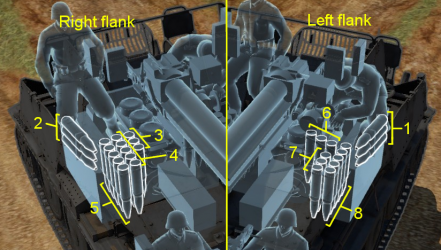
Ammo racks of the Marder III
| Fullammo | 1strack empty | 2ndrack empty | 3rdrack empty | 4thrack empty | 5thrack empty | 6thrack empty | 7thrack empty | 8thrack empty | Visualdiscrepancy |
|---|---|---|---|---|---|---|---|---|---|
| 30 | 28 (+2) | 25 (+5) | 22 (+8) | 17 (+13) | 12 (+18) | 9 (+21) | 6 (+24) | 1 (+29) | No |
Notes:
- Turret «cheeks» empty (racks 1 & 2 empty): 25 (+5).
- Right flank empty of shells (racks 1 to 5 empty): 12 (+18).
| 7.92 mm MG37(t) | ||||
|---|---|---|---|---|
| Mount | Capacity (Belt) | Fire rate | Vertical | Horizontal |
| Hull | 1,200 (200) | 769 | -11°/+20° | ±10° |
